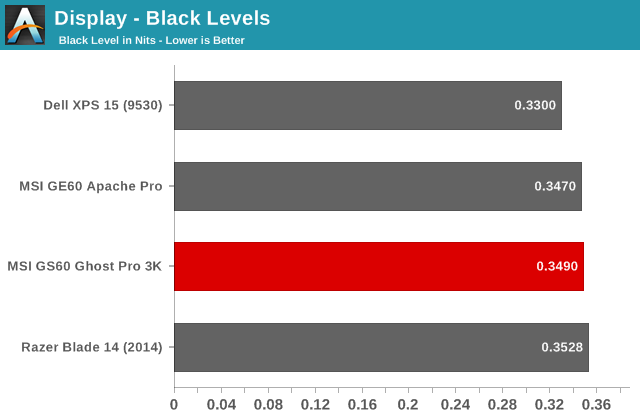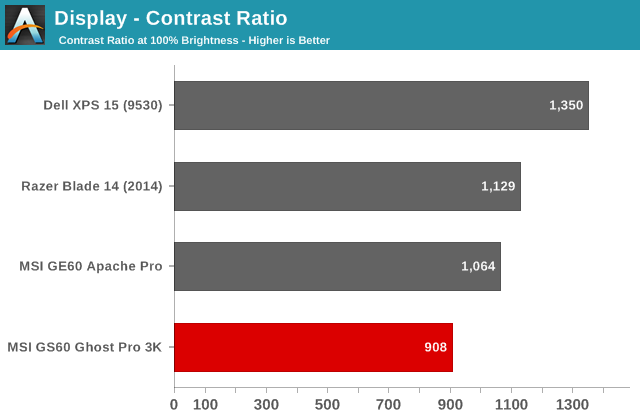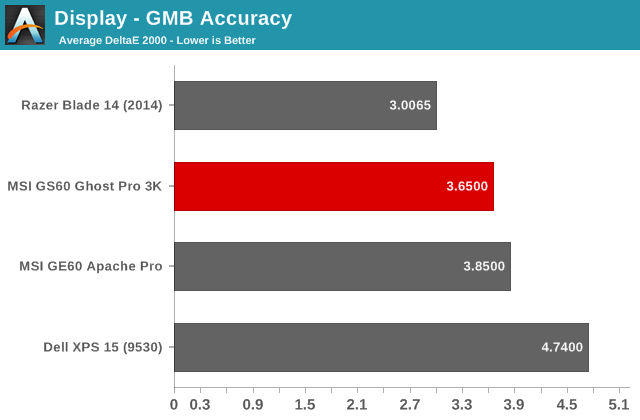MSI GS60 Ghost Pro 3K Review
by Jarred Walton on August 21, 2014 6:00 AM ESTMSI GS60 Ghost Pro 3K LCD: HiDPI, Decent Colors
The one great benefit of buying a system with a 3K display right now is that you're guaranteed two things: first, you'll have the option for using higher resolutions if/when those become more useful, but second and more importantly: you get something other than a low quality TN panel. The GS60 display is an IPS panel manufactured by Panasonic, model VVX16T029D00. As I mentioned earlier, it apparently uses an RGBW grid instead of the more desirable RGB stripe, and that does some interesting things to the color accuracy.
Before calibration, the display looks decent overall – not perfect, but not as bad as some displays that I've seen in recent months. Oddly, however, calibrating the display actually made things look more bluish, and the overall results improved in some areas and either stayed the same or in some cases even got worse in others. It's possible that CalMAN simply isn't handling RGBW properly, or more likely RGBW just doesn't allow for truly accurate colors across the entire color gamut. Here are the results of our LCD testing, including pre- and post-calibration scores.








The white level of 317 cd/m2 is a good starting point, and with a black level of 0.349 nits at max brightness we end up with a contrast ratio of 908:1. That's not the best result that we've ever seen from a laptop, but it's not something I'd complain about. Dropping the brightness to 60% gives us a 200 nits white level with a 776:1 contrast, so it's a bit lower but still good. The native white point is also good compared to some of the other recent MSI laptops I've seen; it's lower than expected at around 6000K, but that's at least getting somewhat close to the "ideal" 6504K. Color accuracy is also fairly reasonable, which brings us to the full uncalibrated results:
Grayscale results are good up until about 45%, at which point the errors start to become visible. From 45% up to 100%, the Delta E is above 3.0, but it stays around 4.0 and never actually hits the 5.0 mark. It's not exceptionally accurate, but that's a better result than some other laptops I've looked at, and the average dE is 3.2. Results in the other charts tell a similar story, with some colors staying below 3.0 while others max out at around 6.0. Overall, the average dE is around 3.5 prior to calibration.
Post-calibration is where things become unusual. The greyscale DeltaE improves dramatically, measuring just 0.4 on average with the only result above 1.0 coming at pure black (not unusual as LCDs generally can't produce perfect black). On the other hand, the DeltaE on the gamma, saturation, and GMB charts only shows minor improvements, with the average dE being around 2.6. Certain colors still show errors of nearly 5.0, and about half of the colors still have a dE above 3.0.
What that means is that out of the box, the display will be good for most users, but if you demand accurate colors then you'll want to look elsewhere, as even professional calibration tools are unable to completely fix the color accuracy. Given the target market of gamers, however, the color quality and accuracy are not a major concern.


_thumb.png)
_thumb.png)
_thumb.png)



_thumb.jpg)
_thumb.jpg)
_thumb.jpg)
_thumb.jpg)
_thumb.jpg)
_thumb.jpg)








47 Comments
View All Comments
blackmagnum - Thursday, August 21, 2014 - link
Holy Ghost! Look at the price for a 4-1=3K gaming notebook. Please chime in...Flunk - Thursday, August 21, 2014 - link
Yes, it is pretty good isn't it? You'd think a system with a 3K screen, Geforce GTX 870M and high-end i7 would be more overpriced, particularly a thin and light like this one.odell_wills - Thursday, October 9, 2014 - link
I do agree that it seems pretty good, but I don't understand why people get in when there are fantastic laptops out there (see http://www.consumertop.com/best-laptop-guide/ for example).Dug - Thursday, August 21, 2014 - link
It is good considering the components. 870m, high end i7, 2x SSD's, 3k screen, at 4.3lbs and .78" thick is amazing.LauRoman - Thursday, August 21, 2014 - link
No jokes about the price of the unit as configured?boozed - Thursday, August 21, 2014 - link
There are jokes?StickyIcky - Monday, August 25, 2014 - link
I see what you did there...DanNeely - Thursday, August 21, 2014 - link
"The testing environment for this workload is unfortunately not fully temperature controlled, but that can be good in that the summer months allow for a better "worst case" scenario. For these tests the ambient temperature (in my office that has no AC, ugh...) was between 80-90F."If you're too cheap to buy one for personal comfort, you really ought to hit Anand up for $120 as a business expense to put a cheap window AC in your office to achieve reasonably consistent thermal benchmarks.
weiran - Thursday, August 21, 2014 - link
I can't believe they sacrificed so much battery life just so they could put a 1TB HDD in there. Unless you're tethered to a power socket all day, it's hard to recommend this machine just because of that one deficiency.willis936 - Thursday, August 21, 2014 - link
Honestly it's time to start seeing single drive systems with 1TB SSDs. If they're getting down to .30c/GB then these fancy high end $2k pocket holes should really be all solid state.